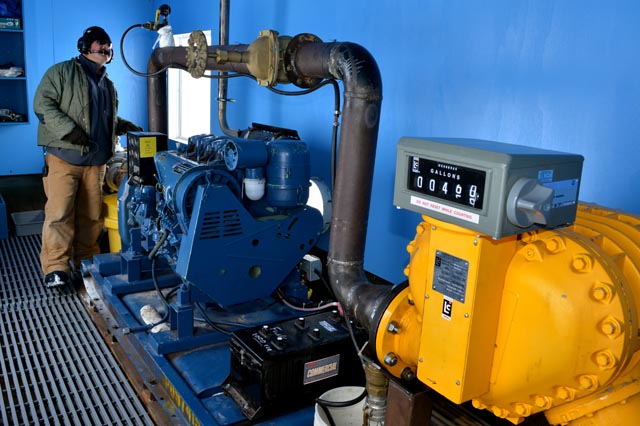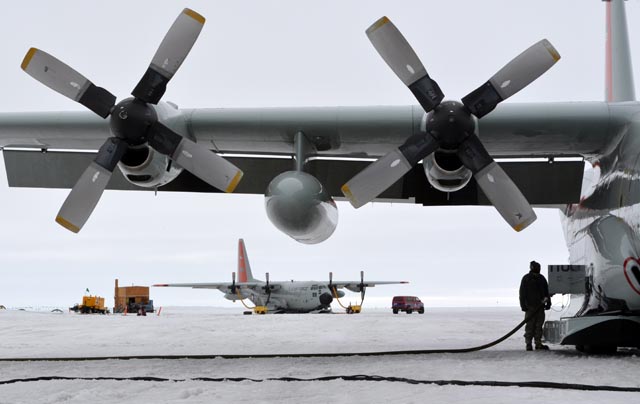|
Page 2/2 - Posted March 29, 2013
Fuels Department puts pedal to the metal at end of seasonEd Cleary, a stout, bald-headed fellow with a strongman mustache, is a fourth-year fuelie. He had known about the U.S. Antarctic Program (USAP) since the late 1990s while attending The Ohio State University “It’s just outside the box. You’re not in a cubicle. I’ve done the cubicle thing,” Cleary says of why he returns each year to the Ice and Fuels in particular. Morris estimates that about two million gallons of fuel passes through those 14 miles through the course of a summer, which runs from about October to February, when it’s time to clear the lines and roll up the hose for the winter. The operation is called pigging. It’s the most dangerous job of the season, according to Morris. 
Photo Credit: Peter Rejcek
Fuelie Matthew Ulsh opens at valve at the Pegasus Airfield fuel tank farm.
Photo Credit: Robyn Waserman/Antarctic Photo Library
Hose is laid out on the McMurdo Station ice pier in preparation of unloading the fuel tanker during a previous season.
Pigging sounds simple enough. A foam rubber bullet is shot through the hose to push the fuel seven miles in each direction into awaiting tanks. But there’s a lot of pressure being exerted through the lines. “If it goes bad, it can go bad in a hurry,” Morris notes. “It would be the effect of a bomb going off.” The other big show for Morris and his fuelies also happens toward the end of the summer season when a fuel tanker — “No Smoking” emblazoned in giant red letters on the bridge — arrives with five millions gallons or so of petrol. It can take upwards of three days of around-the-clock operations to unload the ship. Progress is marked as the vessel’s hull rises out of the water as its storage tanks are emptied. The department handles three types of fuel — AN8, JP5 and mogas, for motor gasoline. The last would be the most familiar to the common consumer, a mid-grade unleaded motor fuel with certain additives that the military requires. AN8 is a special fuel blend unique to the Antarctic and Arctic. It has a lower flash point of 100 degrees Fahrenheit, which also lowers the gelling point when extreme cold temperatures can cause wax crystals to start forming in the fuel. AN8 will remain liquid until about minus 72 degrees, according to Morris. “The big reason for this is the South Pole and the field camps that will see temperatures colder than that,” he says. The New York Air National Guard’s LC-130s JP5 is also a special fuel blend. It is used by the U.S. Coast Guard This year, with construction of a new two-million-gallon tank, McMurdo Station has the capacity to store about 13 million gallons of fuel. That’s enough gas to keep the USAP going for two years. The National Science Foundation (NSF) While the job for the Fuels Department remains the same from summer to summer — and winter to winter — there are no typical years. “This will be the busiest year I’ve seen for fuels — and I thought last year was the busiest year,” Morris muses. “I absolutely love my job,” he adds. “It comes with aggravation and all that, but I couldn’t really see myself doing anything else. I enjoy the people. I enjoy the challenges. And I keep learning new stuff every year.” |



For USAP Participants |
For The Public |
For Researchers and EducatorsContact UsNational Science FoundationOffice of Polar Programs Geosciences Directorate 2415 Eisenhower Avenue, Suite W7100 Alexandria, VA 22314 Sign up for the NSF Office of Polar Programs newsletter and events. Feedback Form |



